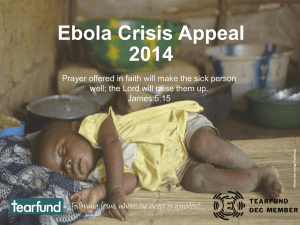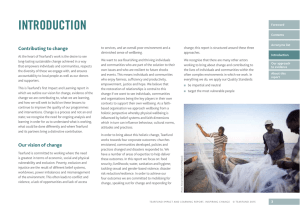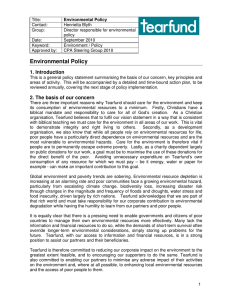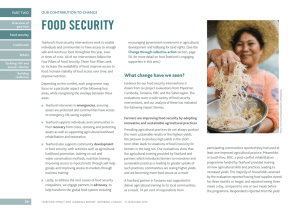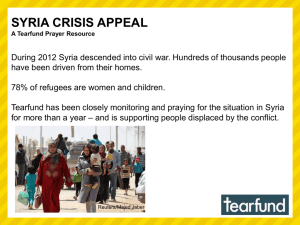Quality Standards Field Guide: Humanitarian & Development Work
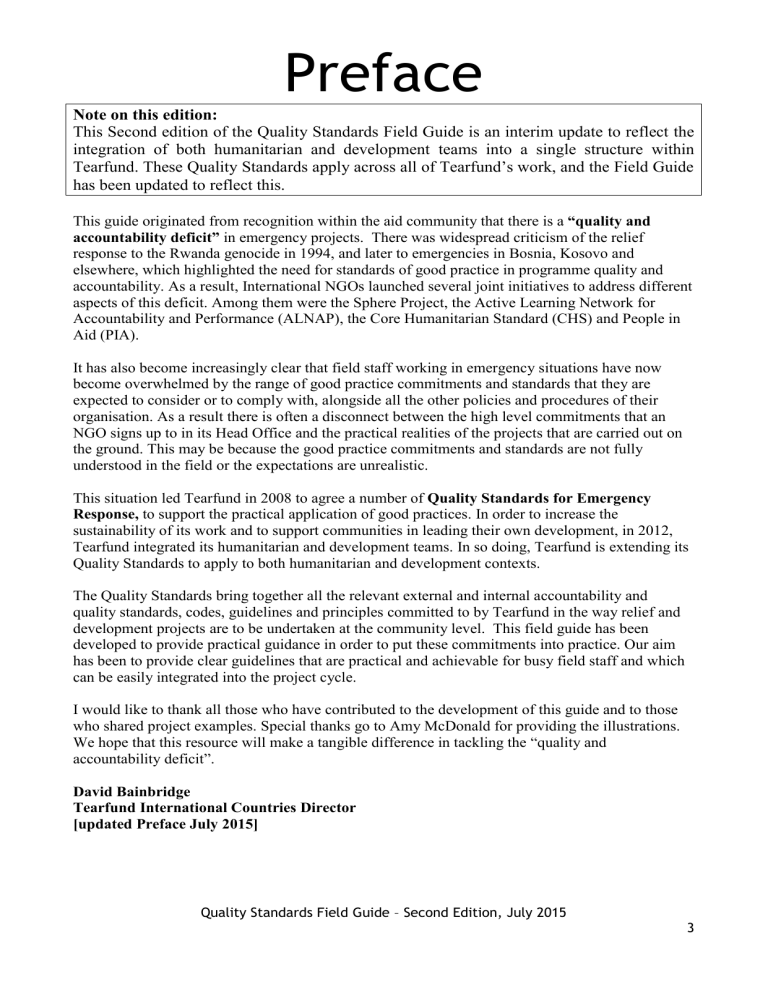
Preface
Note on this edition:
This Second edition of the Quality Standards Field Guide is an interim update to reflect the integration of both humanitarian and development teams into a single structure within
Tearfund. These Quality Standards apply across all of Tearfund’s work, and the Field Guide has been updated to reflect this.
This guide originated from recognition within the aid community that there is a “quality and accountability deficit”
in emergency projects. There was widespread criticism of the relief response to the Rwanda genocide in 1994, and later to emergencies in Bosnia, Kosovo and elsewhere, which highlighted the need for standards of good practice in programme quality and accountability. As a result, International NGOs launched several joint initiatives to address different aspects of this deficit. Among them were the Sphere Project, the Active Learning Network for
Accountability and Performance (ALNAP), the Core Humanitarian Standard (CHS) and People in
Aid (PIA).
It has also become increasingly clear that field staff working in emergency situations have now become overwhelmed by the range of good practice commitments and standards that they are expected to consider or to comply with, alongside all the other policies and procedures of their organisation. As a result there is often a disconnect between the high level commitments that an
NGO signs up to in its Head Office and the practical realities of the projects that are carried out on the ground. This may be because the good practice commitments and standards are not fully understood in the field or the expectations are unrealistic.
This situation led Tearfund in 2008 to agree a number of Quality Standards for Emergency
Response, to support the practical application of good practices. In order to increase the sustainability of its work and to support communities in leading their own development, in 2012,
Tearfund integrated its humanitarian and development teams. In so doing, Tearfund is extending its
Quality Standards to apply to both humanitarian and development contexts.
The Quality Standards bring together all the relevant external and internal accountability and quality standards, codes, guidelines and principles committed to by Tearfund in the way relief and development projects are to be undertaken at the community level. This field guide has been developed to provide practical guidance in order to put these commitments into practice. Our aim has been to provide clear guidelines that are practical and achievable for busy field staff and which can be easily integrated into the project cycle.
I would like to thank all those who have contributed to the development of this guide and to those who shared project examples. Special thanks go to Amy McDonald for providing the illustrations.
We hope that this resource will make a tangible difference in tackling the “quality and accountability deficit”.
David Bainbridge
Tearfund International Countries Director
[updated Preface July 2015]
Quality Standards Field Guide – Second Edition, July 2015
3
Preface
"Field staff have become overwhelmed by the range of good practices and standards"
"The Quality Standards bring together all the relevant external and internal accountability and quality standards, codes, guidelines and principles committed to by Tearfund"
Quality Standards Field Guide – Second Edition, July 2015
4
Introduction
How to apply the Quality Standards
The Quality Standards are not intended to be used as a “passed/failed” checklist and we recognise that meeting these standards isn’t usually a simple “yes/no” answer, but more a case of seeking continually improving levels of compliance.
Their purpose is to increase the quality, effectiveness and impact of the projects that Tearfund supports, by providing a framework to guide such responses in the following ways:
serving as a tool for capacity development of partners and of staff;
to inform the work of project designers in analysis of their context and prioritising good practice commitments;
for periodic self-appraisal;
and as an essential part of project monitoring & evaluation.
They are cross cutting, meaning that they apply to all types of project, regardless of sector or stage in the life of the project.
The Quality Standards are intended to guide all Tearfund Operational Programmes and Tearfund’s partners as they undertake emergency response, disaster recovery and on-going development work. In supporting these partners, Tearfund’s aim is not to impose rules but to facilitate partners who share our commitment to good practice, and to improve the quality of work in the community. With this in mind, most of the Quality Standards are prioritised according to context. However, the first three Quality Standards: Values, Impartiality and Targeting and
Accountability are non-negotiable and apply wherever Tearfund works. This is explored further, below.
Consistent with Tearfund’s vision and commitment to mobilising local churches, guidance has also been developed on working with and through local churches in emergency situations. Tearfund recognises the responsibility that local churches have to meet needs in their community during times of crisis, and that they have many strengths and niche areas, which can complement and strengthen the work of NGOs. Effective partnership of NGOs with local churches brings together their respective strengths and capacities. A link to this guidance is here: Disasters and the local church .
The Standards need to be reviewed and prioritised in relation to each project context e.g. Disaster Risk will be a critical concern in a reconstruction programme following an earthquake, whereas Environment will be a major consideration in a situation of desertification or increased drought brought about by climate change.
Quality Standards Field Guide – Second Edition, July 2015
5
Introduction
Whilst there is always a need to prioritise, the following are non-negotiable commitments in all situations:
Values: ensuring staff understand and live out the values and are clear on what is unacceptable conduct.
Impartiality: assistance must always be provided on the basis of need alone. Clear criteria are required to identify those who are in greatest need or most vulnerable.
Accountability: ensuring the full participation of project participants, sharing information, and receiving and responding to their feedback.
Minimum requirements to ensure safety of project participants. This particularly relates to the Quality Standards on Children (ensuring we carry out our child protection commitments), Gender (ensuring projects enhance safety for women), HIV (ensuring projects do not make people more vulnerable to HIV) and Conflict (ensuring the project design does not heighten people’s vulnerability to violence and conflict). An analysis is required and actions identified to ensure safety of project participants and that projects “Do No Harm”. It may at certain times be necessary to overlook certain commitments in order to ensure safety of project participants. For example, it may sometimes be necessary to avoid disclosing information that identifies project participants and their entitlements, in order to uphold their safety. Any such decisions should be clearly documented.
How to use this Field Guide
This field guide is intended to provide simple, practical guidance for field staff in order to equip them to put Quality Standards into practice in their projects. It is divided into two sections:
Section One
In this section each Quality Standard is presented with:
A summary of the Quality Standard, explaining the key issues, biblical foundations, good practice commitments and close links with other Quality
Standards
A summary of the most useful reading materials in support of the Quality
Standard
A series of practical steps for staff to follow in order to put the Quality
Standard into practice in the stages of the project cycle
Short examples to show how the Quality Standard has been put into practice in different types of project.
Quality Standards Field Guide – Second Edition, July 2015
6
Introduction
At the end of Section One, there are checklists provided on the specific ways in which the Quality Standard should be considered within the first three stages of the project cycle: Identification, Design and Implementation (for the purposes of this guide, monitoring and evaluation activities, which are sometimes included in the Evaluation phase, have been included under Implementation).
Identification
Evaluation
Design
Implementation
Section Two
The second section of the guide provides a summary of the main international codes and standards that are used by NGOs. These were used to guide the selection of Tearfund’s Quality Standards, which were originally relief focussed.
More recently, Tearfund’s Standards have been broadened to include not only relief but also other types of longer-term project.
Quality Standards Field Guide – Second Edition, July 2015
7






